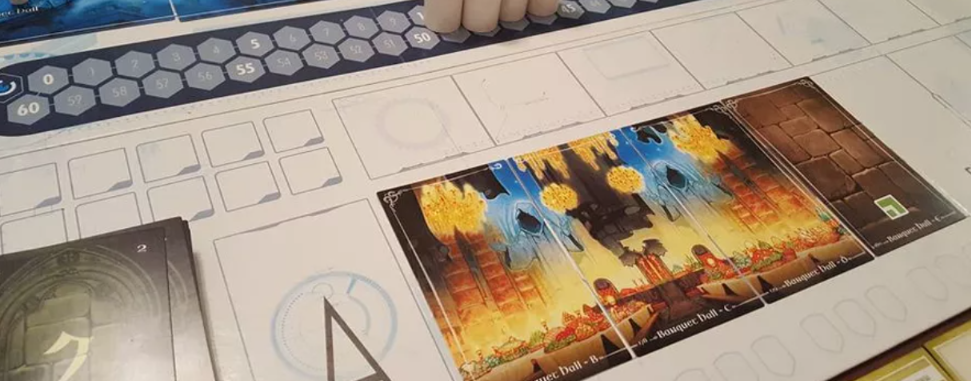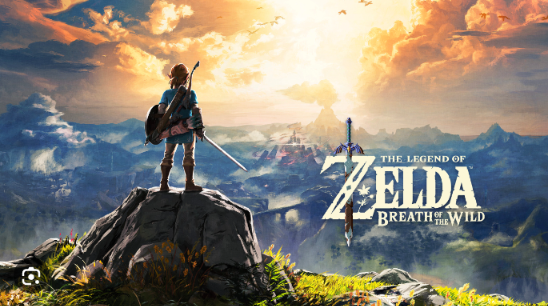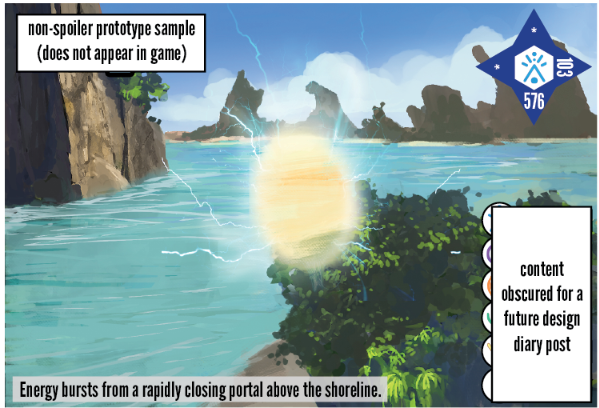This is a compilation of the designer diary entries posted in the Vantage Facebook group and on BoardGameGeek. They are listed here in chronological order, with the most recent entry at the top.
***
April 2024: Early Inspirations and Movement
Welcome to the first update for Vantage! I sent this as a monthly newsletter today; you can subscribe here.
Early Inspirations
The earliest ideas I had for Vantage were about cliffs and crowds, then Breath of the Wild changed everything.
Way back in 2016, I had two seemingly unrelated game ideas. Neither of these concepts are what Vantage would eventually become, but I can still see elements of them in the final game.
- You wake up in a small room carved into the side of a sheer cliff. You have no idea how you got there or where you are. You–the player–don’t even know the rules: All you have is a card depicting the room. When you look closer, you notice some instructions in the art, carved into the wall. In that way, starting small and unraveling from there, you learn how to play at the same pace that your character learns about the room and the world outside.
- You are on a crowded battlefield, a mass of people in your field of vision. The only person you can’t see is yourself, as you have but one card, and it is from the first-person perspective of your character. Each other player had a similar card from the perspective of someone else on the battlefield. The game was about finding each player by communicating each perspective.
Both ideas shared my favorite element of one of my favorite games, TIME Stories. In that cooperative game, players enter a new location together and are faced with a first-person scene. They immediately spread out, each looking at a card before returning it and talking about what they saw. I loved this thematic reasoning for having limited information despite open communication in a cooperative game, and I wanted to explore it my own way.

Then in March 2017, Zelda: Breath of the Wild appeared.
As soon as I started seeing footage of Breath of the Wild, I was struck by how much was packed into every frame. There were so many interesting things to see, and you actually used your eyes–there weren’t dozens of map markers telling you where to look.
Even better, if you could see something, you could go there and interact with it–maybe in a few seconds, maybe in a few hours or more. Along the way, you might discover a dozen other things to explore. And if you stop seeing anything interesting in one direction, you could turn away and move elsewhere.
The freedom in Breath of the Wild was staggering. This was a game that said “yes” to the player, allowing your intrinsic motivations to steer you. Do you want to climb that cliff, fight this monster, chase a chicken, search for a sword, or cut down a tree? Yes, yes, yes, yes, and yes.
All of this, and the game still had an overall goal: Destroy Ganon. Right from the start, you can see the corrupted castle–you can even go there right after the tutorial. Or you could first explore every inch of the vast world. Or something in between.
I was–and still am–enamored by all of this. And I’m not even a video gamer. In fact, the vast majority of my experience with Breath of the Wild is through other peoples’ eyes: Watching videos of people play and talk about what they love about the game. I discovered channels like Game Maker’s Toolkit, Cool Ghosts, and Snoman Gaming.
It was while immersing myself in the joys of Breath of the Wild research that Vantage truly started to take shape. I wanted to create a world as large and richly populated as Hyrule, a game that said “yes” to players as they moved in any direction and interacted with the land. A game from a first-person perspective, not top-down–a game that asked you to use your eyes and intuition, a game the rewarded curiosity and discovery.
I didn’t know it at the time, but in some ways Vantage ended up being even bigger than Breath of the Wild. Hyrule has outer limits, but Vantage is an entire planet. While difficult, it is technically possible for you to walk all the way around the world of Vantage vertically or horizontally and end up back where you started.
Many games and other forms of media influenced the 7-year design process for Vantage, but none moreso than Zelda: Breath of the Wild (hence the codename for the game: Wild). I’ll share some of those other inspirations in future posts.

Gameplay Example: Movement
In these monthly updates I’d like to share via specific examples of the gameplay so you can learn exactly how the game works, not just talk about the design process. In this first update I’ll demonstrate movement from location to location.
In Vantage, because players are stranded far from each other on a vast planet, only you can see your location (just as you cannot see other locations). Your location is a large card placed upright in front of you in a card holder. You’re always facing north, literally looking through your character’s eyes–instead of a miniature, you are your character.
Among the various actions to choose from on your turn is to move from your location to an adjacent location in any cardinal direction. In the example below, the compass shows that you can easily walk east or south. If you do, after completing the action, simply return the current location card to the box in numerical order (its place reserved by your placeholder card) and find location card 103 or 576 to place in your card holder.
You could instead move north or west, but the difficulty of these directions is unknown. This is one of the ways that using your eyes matters in Vantage. Are you adept at moving–or, specifically, moving across water? Does the water appear calm or stormy? Do you or other players have advice to offer (mechanically) for such movement? It is only after you commit to moving north or west on this location that you will learn the difficulty, perform the action, and go to the resulting location.
This is how movement works in Vantage. Nearly every location (of close to 800 unique locations) allows you to move in any direction as your turn. In this way, whenever you move, you’ve created a new branching path in your story. Even if luck has it that you crash on the exact location (a 1 in 126 chance), you can move in a different direction for a new adventure.

Do you have a favorite open-world game, either digital or tabletop? What about the game made it so special and memorable for you?
April 24, 2024: Announcement Day Livestream
The livestream that followed the newsletter in which we announced Vantage is here:
26 Comments on “Design Diary”
Leave a Comment
If you ask a question about a specific card or ability, please type the exact text in your comment to help facilitate a speedy and precise answer.
Your comment may take a few minutes to publish. Antagonistic, rude, or degrading comments will be removed. Thank you.
Aaah…
…Wild becomes Vantage. I’ve been following this one since 2017. And I’m along for the ramp-up (or touch down?) until its release next year. My type of game experience at long last. Thanks J!
– Marcel Claxton
designer Vindication Chronicles
host of Story Tiles
I’m honored by your interest in Vantage, Marcel! Thank you!
Hey Jamey! I think I’m on the fence with Vantage. Mostly because my shelf of shame has about 75 games on it, yet to be played.
My favorite open world games have been The Witcher 3, Red Dead Redemption, Ghost Recon Wildlands, The Division, and about 8 more on my video game shelf of shame.
Have kids, they said…
I call it my “shelf of opportunity.” You have a year until Vantage is available to get through some of those games! :)
Really looking forward to this one!
About my favourite open world game: nothing beats roaming the streets of ancient Greece in AC Odyssey. ;-)
Very stoked about this! I have one question about the movement system. If you’re always facing north, does that impact your ability to make informed decisions about exploring south? Would this be a hindrance in a run where your objective mostly takes you south? Or are the starting locations and objectives designed to bias you towards movement to the north anyway?
Thanks Martin! South is indeed the location that you have the least information about, but you have a rough idea based on the terrain near the bottom edge of your current location. If it’s a particularly difficult movement, I include hints in the text of the current location so you’re not caught off guard (before I added those hints, playtesters were definitely more hesitant to move south when the difficulty was unknown). There aren’t any objectives that require you to move in any specific direction–that’s your choice to make. :)
First, I have an entire wall shelf dedicated to SM games (and the numbers keep growing), because I really like the games you create. Second I am glad you put out information on this “wild” new adventure you have been planning too quiet the haters who have griped about releasing the metal coins.
What I find amazing is how one creators ideas show up in other places. Your idea has similarities to the 7th Continent, SpiritFire and Sleeping Gods. Since SpiritFrire has not been released yet, I cannot comment on the game, only my sheer excitement and anticipation for release. However, I own and play both 7C and SG and I love them! From the moment you mentioned a new adventure game coming, I immediately told my wife and started a game fund so I can immedialty go ALL IN.
I hope you will have interaction with us the buyers/players in regards to possibly certain aspects of the game where we can vote for this that or the other. A game of this magnitude could benefit greatly from a popular consensus.
Thanks for the update, I look forward to the next!
I’m honored to hear that you have a Stonemaier wall! :)
I’ve announced Vantage at a time when most decisions for the game have already been made, but if there’s anything I’m uncertain about in terms of what people want, I’ll definitely ask in a survey of poll. :)
This is so fresh and exciting. Thank you for sharing.
My go to open world game is Witcher series.
Nice! The Witcher 3 is a game I studied, particularly to learn about sidequests.
Wow, what a huge and interesting project! An open world coop boardgame; count me in. It reminds me of the fun I had playing 7th Continent. I played a lot of: Horizon Zero Dawn, Civilization, Panzer General and No Man’s Sky. What I like about these (open world) games: freedom of choice, exploring, progression (finding stuff, getting experience, tech tree, new abbilities, upgrades, achieving goals, some threat/ennemies).
Wishing you all the best finalizing Vantage!
Thanks Bart! Vantage shares a lot of those elements you listed. :)
I love the background of the inspiration for Vantage. Since you shared quite a bit of that in this week’s webcast, I found the best part of this diary entry to be about the movement. It sounds like a really interesting mechanism and unlike one that I’ve personally encountered in a tabletop game. It’s amazing to have such flexibility/choice in the game. I am thankful you chose to let us in on Vantage earlier than you typically would. Given the amount of time you’ve spent putting it together, I can imagine you have been dying to share something!
I am curious about the 7 year timeframe – was it so lengthy because you couldn’t dedicate more bandwidth to it or because of the volume of work needed for a game of this nature? Perhaps it was due to external factors beyond your control? Perhaps you found yourself needing to step away to come back with a fresh perspective? Could you share more insights about why it took so long? (I hope that didn’t come across sounding judgmental – I’m just intrigued since it’s so much longer than you said the typical development of a game takes.)
Thanks Jonathan! You’re right that I’ve been very eager to talk about the game, and that’s a good question about why it’s taken so long. For significant portions of the 7 years, I’ve spent quite a bit of time on the project (probably averaging around 15-20 hours per week on it). Sometimes that changed if another project needed my full attention. For a while, it took so long because I didn’t know what the game should be or what would be in the world. I’ll talk later about how working with the artists to create the world addressed that uncertainty, but it took quite a bit of time for them to create all that art, and in the meantime I was still figuring out the gameplay. Then, when I finally had most of the gameplay figured out, I had to write each of the 6000+ actions–it was a daunting proposition that took me nearly a year to complete. Then there were transitions when I had to shift those actions from one format to another (that was the case whenever I made a global change). If the world was just 50 or 100 locations, I could have finished a while ago. But 800 locations and 900 other cards to discover? It just took a lot of time to design them all. :)
I have no idea what 7 years in board game design means from a professional point of view. Whether it’s a long or short time. To me, it seems like a long time, especially in an industry where time is dense with all this plethora of games being published. Were you sceptical at any point, that after 7 years of designing, the game will feel outdated? And how did you ensure that this won’t happen?
It’s quite a long time. :) Most games I’ve designed have taken 1-2 years from start to finish.
That’s an interesting question. Outdated? No, especially not with the game evolving so much along the way (the final version is significantly different than the early versions). Rather, I was a little worried that another game with the same hook would be released in the meantime.
Thank you for your reply and thank you for all the games that you have given us. You make our hobby better in so many ways :)
Like David Evers, my first thought also was Myst (and Riven). To date it’s still my favorite PC game; I love the setting, mystery, puzzles, and exploration. I’m very much looking forward to following the design journey of Vantage!
My immediate reaction when reading the first paragraphs was ‘Myst’: movement, interaction, and observaton being key to completing the quest.
I can definitely see that comparison!
Reminds me a bit of those old Sierra adventure games like King’s Quest. I loved playing those as a kid.
I can see that comparison!
I am so pumped to go on this journey, and read these posts over the upcoming year!
I’m curious if you had any long conversations with Ryan Laukat about world building, and its challenges in the board game space?
Thanks Jamey! :)
Thanks Ross! I’m fortunate to be industry friends with Ryan, and we’ve chatted about world-building and open-world games. I love what he created in both versions of Sleeping Gods.